sensor MAZDA MODEL 6 2009 Owners Manual (in English)
[x] Cancel search | Manufacturer: MAZDA, Model Year: 2009, Model line: MODEL 6, Model: MAZDA MODEL 6 2009Pages: 464, PDF Size: 4.61 MB
Page 15 of 464
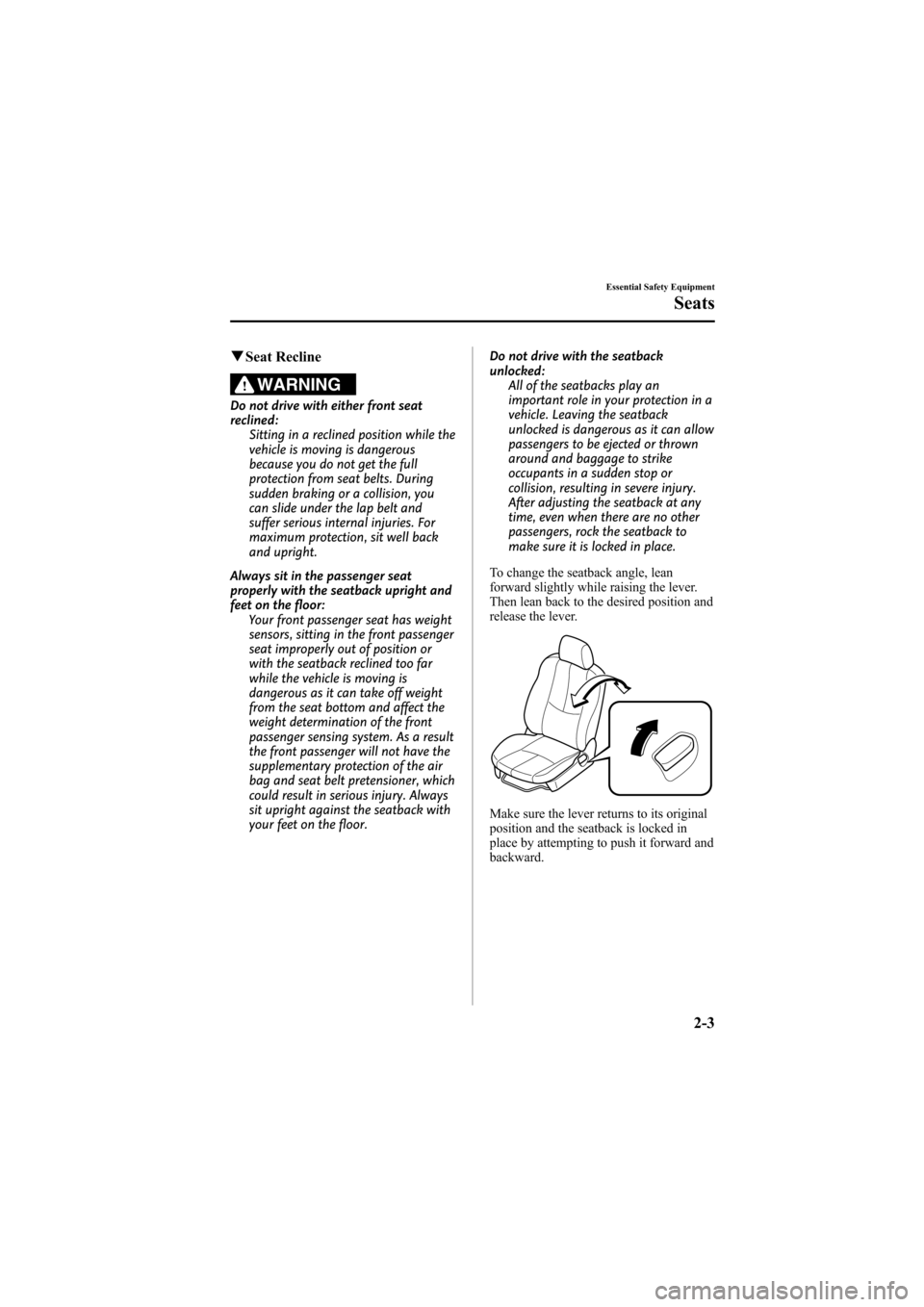
Black plate (15,1)
qSeat Recline
WARNING
Do not drive with either front seat
reclined:
Sitting in a reclined position while the
vehicle is moving is dangerous
because you do not get the full
protection from seat belts. During
sudden braking or a collision, you
can slide under the lap belt and
suffer serious internal injuries. For
maximum protection, sit well back
and upright.
Always sit in the passenger seat
properly with the seatback upright and
feet on the floor: Your front passenger seat has weight
sensors, sitting in the front passenger
seat improperly out of position or
with the seatback reclined too far
while the vehicle is moving is
dangerous as it can take off weight
from the seat bottom and affect the
weight determination of the front
passenger sensing system. As a result
the front passenger will not have the
supplementary protection of the air
bag and seat belt pretensioner, which
could result in serious injury. Always
sit upright against the seatback with
your feet on the floor. Do not drive with the seatback
unlocked:
All of the seatbacks play an
important role in your protection in a
vehicle. Leaving the seatback
unlocked is dangerous as it can allow
passengers to be ejected or thrown
around and baggage to strike
occupants in a sudden stop or
collision, resulting in severe injury.
After adjusting the seatback at any
time, even when there are no other
passengers, rock the seatback to
make sure it is locked in place.
To change the seatback angle, lean
forward slightly while raising the lever.
Then lean back to the desired position and
release the lever.
Make sure the lever returns to its original
position and the seatback is locked in
place by attempting to push it forward and
backward.
Essential Safety Equipment
Seats
2-3
Mazda6_8Z64-EA-08H_Edition1 Page15
Wednesday, June 25 2008 10:3 AM
Form No.8Z64-EA-08H
Page 17 of 464
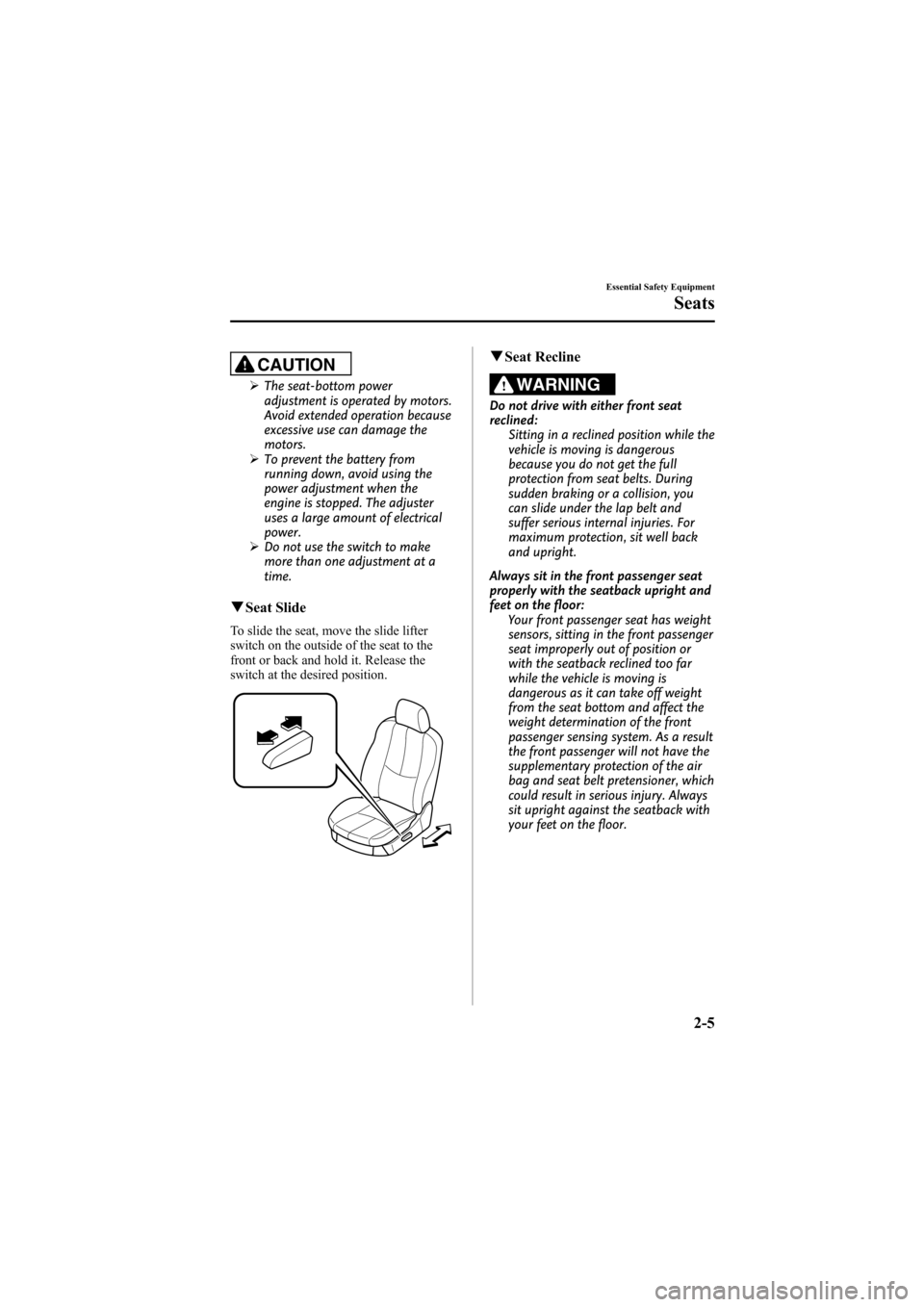
Black plate (17,1)
CAUTION
ØThe seat-bottom power
adjustment is operated by motors.
Avoid extended operation because
excessive use can damage the
motors.
Ø To prevent the battery from
running down, avoid using the
power adjustment when the
engine is stopped. The adjuster
uses a large amount of electrical
power.
Ø Do not use the switch to make
more than one adjustment at a
time.
qSeat Slide
To slide the seat, move the slide lifter
switch on the outside of the seat to the
front or back and hold it. Release the
switch at the desired position.
qSeat Recline
WARNING
Do not drive with either front seat
reclined:
Sitting in a reclined position while the
vehicle is moving is dangerous
because you do not get the full
protection from seat belts. During
sudden braking or a collision, you
can slide under the lap belt and
suffer serious internal injuries. For
maximum protection, sit well back
and upright.
Always sit in the front passenger seat
properly with the seatback upright and
feet on the floor: Your front passenger seat has weight
sensors, sitting in the front passenger
seat improperly out of position or
with the seatback reclined too far
while the vehicle is moving is
dangerous as it can take off weight
from the seat bottom and affect the
weight determination of the front
passenger sensing system. As a result
the front passenger will not have the
supplementary protection of the air
bag and seat belt pretensioner, which
could result in serious injury. Always
sit upright against the seatback with
your feet on the floor.
Essential Safety Equipment
Seats
2-5
Mazda6_8Z64-EA-08H_Edition1 Page17
Wednesday, June 25 2008 10:3 AM
Form No.8Z64-EA-08H
Page 19 of 464
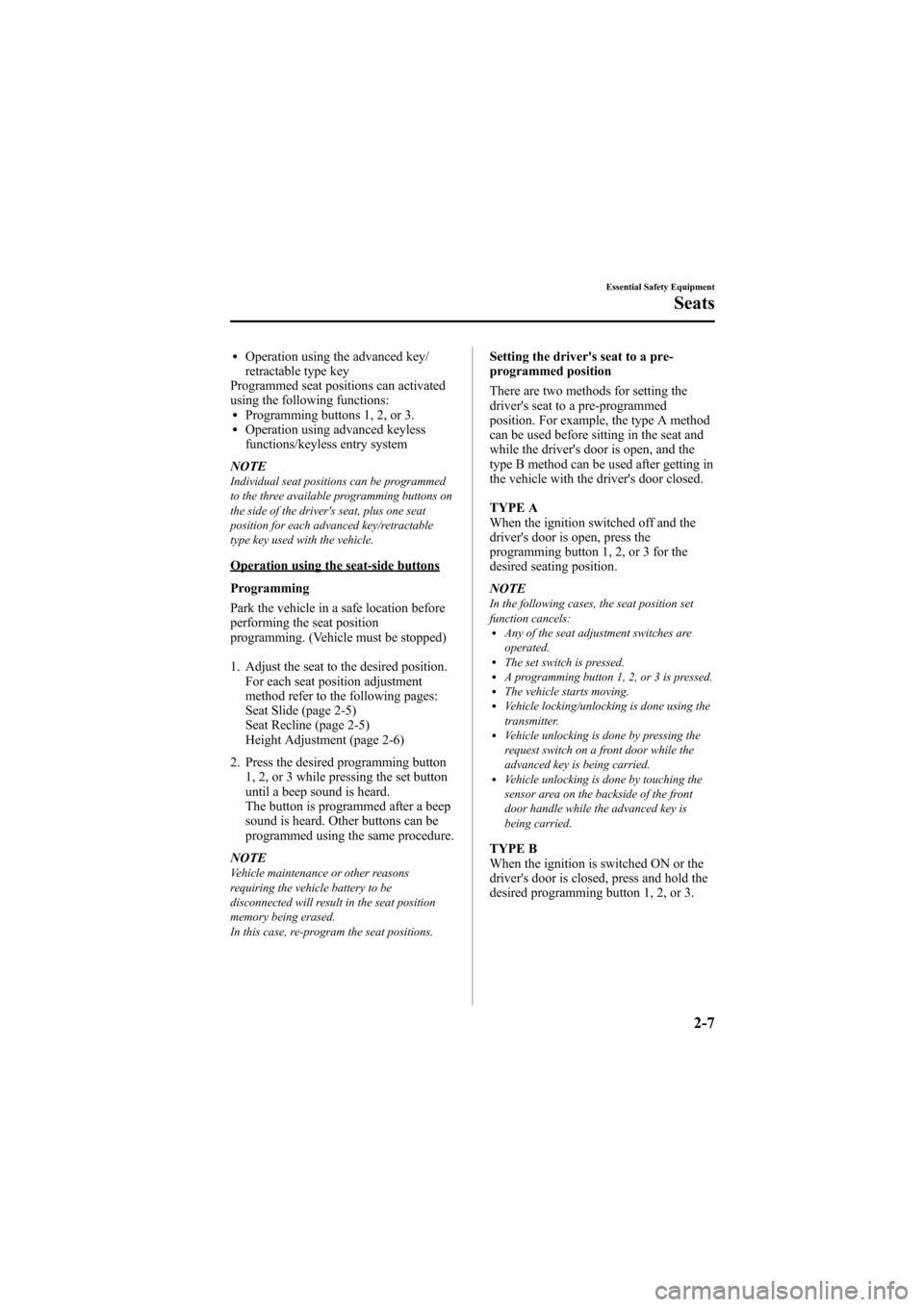
Black plate (19,1)
lOperation using the advanced key/
retractable type key
Programmed seat positions can activated
using the following functions:
lProgramming buttons 1, 2, or 3.lOperation using advanced keyless
functions/keyless entry system
NOTE
Individual seat positions can be programmed
to the three available programming buttons on
the side of the driver's seat, plus one seat
position for each advanced key/retractable
type key used with the vehicle.
Operation using the seat-side buttons
Programming
Park the vehicle in a safe location before
performing the seat position
programming. (Vehicle must be stopped)
1. Adjust the seat to the desired position. For each seat position adjustment
method refer to the following pages:
Seat Slide (page 2-5)
Seat Recline (page 2-5)
Height Adjustment (page 2-6)
2. Press the desired programming button 1, 2, or 3 while pressing the set button
until a beep sound is heard.
The button is programmed after a beep
sound is heard. Other buttons can be
programmed using the same procedure.
NOTE
Vehicle maintenance or other reasons
requiring the vehicle battery to be
disconnected will result in the seat position
memory being erased.
In this case, re-program the seat positions.
Setting the driver's seat to a pre-
programmed position
There are two methods for setting the
driver's seat to a pre-programmed
position. For example, the type A method
can be used before sitting in the seat and
while the driver's door is open, and the
type B method can be used after getting in
the vehicle with the driver's door closed.
TYPE A
When the ignition switched off and the
driver's door is open, press the
programming button 1, 2, or 3 for the
desired seating position.
NOTE
In the following cases, the seat position set
function cancels:
lAny of the seat adjustment switches are
operated.
lThe set switch is pressed.lA programming button 1, 2, or 3 is pressed.lThe vehicle starts moving.lVehicle locking/unlocking is done using the
transmitter.
lVehicle unlocking is done by pressing the
request switch on a front door while the
advanced key is being carried.
lVehicle unlocking is done by touching the
sensor area on the backside of the front
door handle while the advanced key is
being carried.
TYPE B
When the ignition is switched ON or the
driver's door is closed, press and hold the
desired programming button 1, 2, or 3.
Essential Safety Equipment
Seats
2-7
Mazda6_8Z64-EA-08H_Edition1 Page19
Wednesday, June 25 2008 10:3 AM
Form No.8Z64-EA-08H
Page 20 of 464
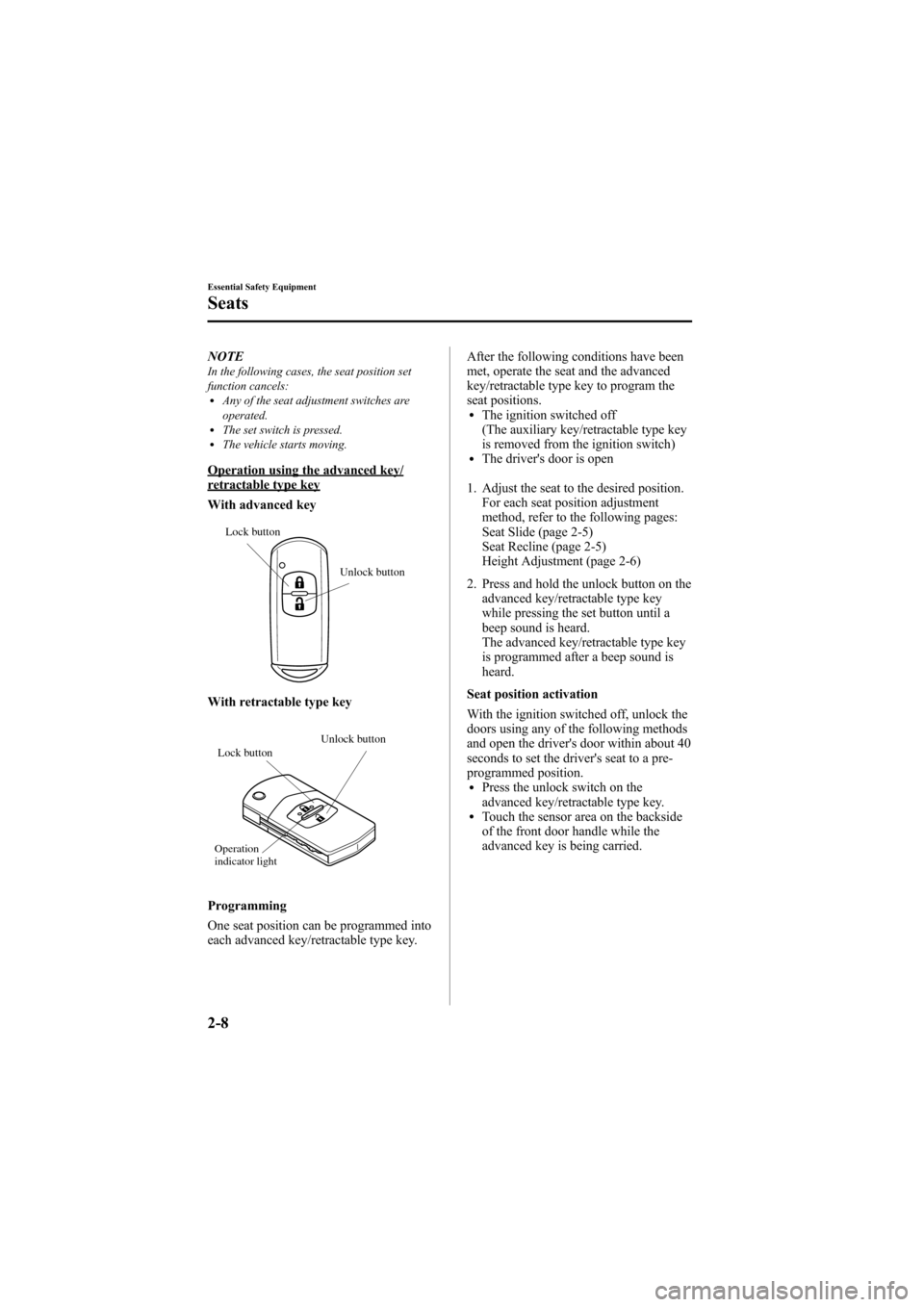
Black plate (20,1)
NOTEIn the following cases, the seat position set
function cancels:
lAny of the seat adjustment switches are
operated.
lThe set switch is pressed.lThe vehicle starts moving.
Operation using the advanced key/retractable type key
With advanced key
Lock buttonUnlock button
With retractable type key
Lock buttonUnlock button
Operation
indicator light
Programming
One seat position can be programmed into
each advanced key/retractable type key. After the following conditions have been
met, operate the seat and the advanced
key/retractable type key to program the
seat positions.
lThe ignition switched off
(The auxiliary key/retractable type key
is removed from the ignition switch)
lThe driver's door is open
1. Adjust the seat to the desired position. For each seat position adjustment
method, refer to the following pages:
Seat Slide (page 2-5)
Seat Recline (page 2-5)
Height Adjustment (page 2-6)
2. Press and hold the unlock button on the advanced key/retractable type key
while pressing the set button until a
beep sound is heard.
The advanced key/retractable type key
is programmed after a beep sound is
heard.
Seat position activation
With the ignition switched off, unlock the
doors using any of the following methods
and open the driver's door within about 40
seconds to set the driver's seat to a pre-
programmed position.
lPress the unlock switch on the
advanced key/retractable type key.
lTouch the sensor area on the backside
of the front door handle while the
advanced key is being carried.
2-8
Essential Safety Equipment
Seats
Mazda6_8Z64-EA-08H_Edition1 Page20
Wednesday, June 25 2008 10:3 AM
Form No.8Z64-EA-08H
Page 21 of 464
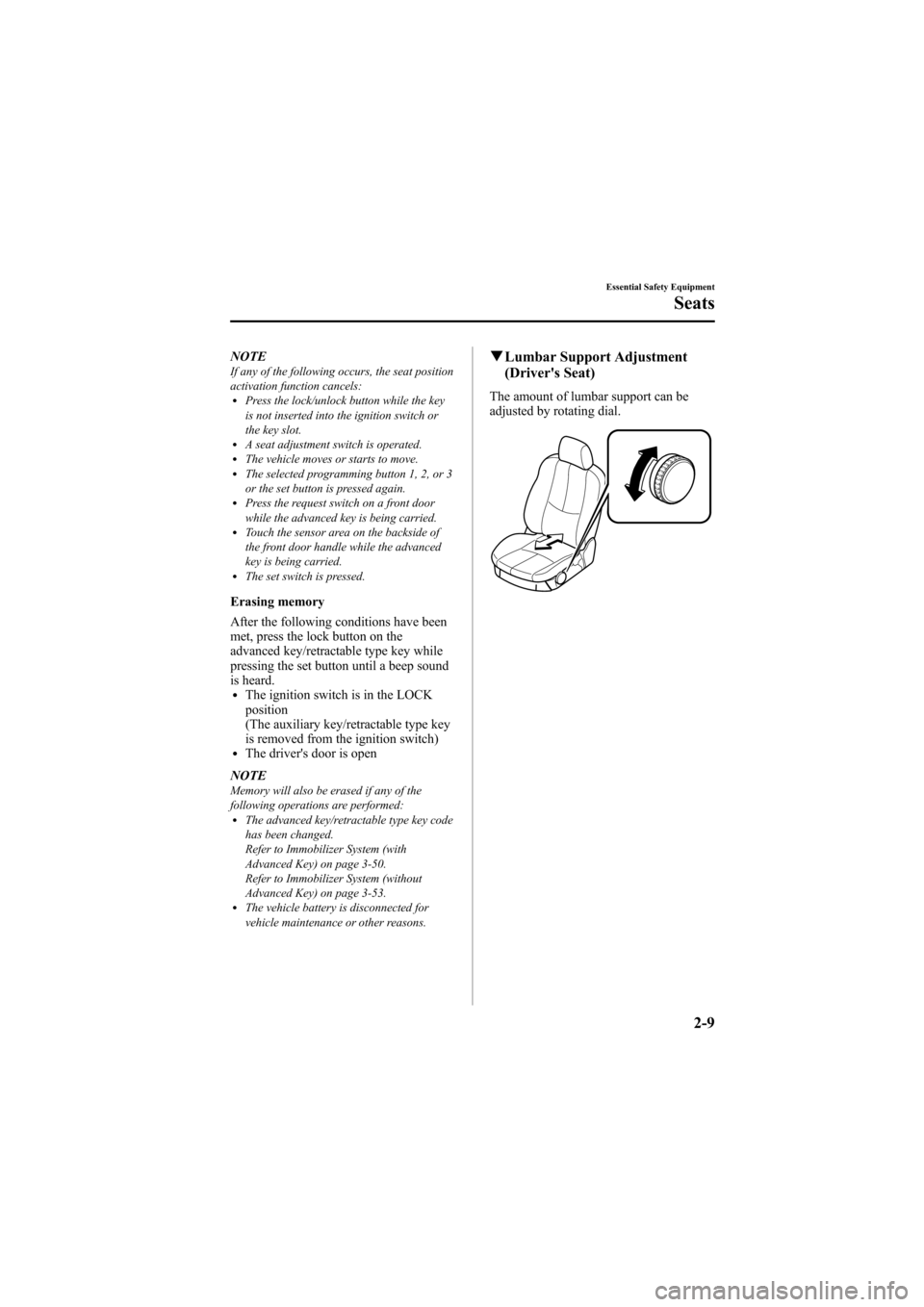
Black plate (21,1)
NOTEIf any of the following occurs, the seat position
activation function cancels:
lPress the lock/unlock button while the key
is not inserted into the ignition switch or
the key slot.
lA seat adjustment switch is operated.lThe vehicle moves or starts to move.lThe selected programming button 1, 2, or 3
or the set button is pressed again.
lPress the request switch on a front door
while the advanced key is being carried.
lTouch the sensor area on the backside of
the front door handle while the advanced
key is being carried.
lThe set switch is pressed.
Erasing memory
After the following conditions have been
met, press the lock button on the
advanced key/retractable type key while
pressing the set button until a beep sound
is heard.
lThe ignition switch is in the LOCK
position
(The auxiliary key/retractable type key
is removed from the ignition switch)
lThe driver's door is open
NOTE
Memory will also be erased if any of the
following operations are performed:
lThe advanced key/retractable type key code
has been changed.
Refer to Immobilizer System (with
Advanced Key) on page 3-50.
Refer to Immobilizer System (without
Advanced Key) on page 3-53.
lThe vehicle battery is disconnected for
vehicle maintenance or other reasons.
q Lumbar Support Adjustment
(Driver's Seat)
The amount of lumbar support can be
adjusted by rotating dial.
Essential Safety Equipment
Seats
2-9
Mazda6_8Z64-EA-08H_Edition1 Page21
Wednesday, June 25 2008 10:3 AM
Form No.8Z64-EA-08H
Page 38 of 464

Black plate (38,1)
Driver seated/Front passenger seated
The seat belt warning function reminds
the front passenger to fasten the seat belt
according to the chart below.
ConditionVehicle speed
Between 0 ―20
km/h
(0 ― 12 mph) 20 km/h
(12 mph) or more
Seat belt
(Driver)
Seat belt
(Passenger)
Indicator
Beep
: Fastened: Unfastened: Illuminated: Flashing: Beep
Placing heavy items on the front
passenger seat may cause the front
passenger seat belt warning function to
operate depending on the weight of the
item.
Once the beep sound is heard, it continues
sounding even if the vehicle speed lowers
to 20 km/h (12 mph) or less until the
seatbelt is fastened or the beep sound
period has passed.
NOTE
lTo allow the front passenger seat weight
sensor to function properly, do not place
and sit on an additional seat cushion on the
front passenger seat. The sensor may not
function properly because the additional
seat cushion could cause sensor
interference.
lWhen a small child sits on the front
passenger seat, it is possible that neither
the warning light nor the warning beep
operate.
2-26
Essential Safety Equipment
Seat Belt Systems
Mazda6_8Z64-EA-08H_Edition1 Page38
Wednesday, June 25 2008 10:3 AM
Form No.8Z64-EA-08H
Page 39 of 464
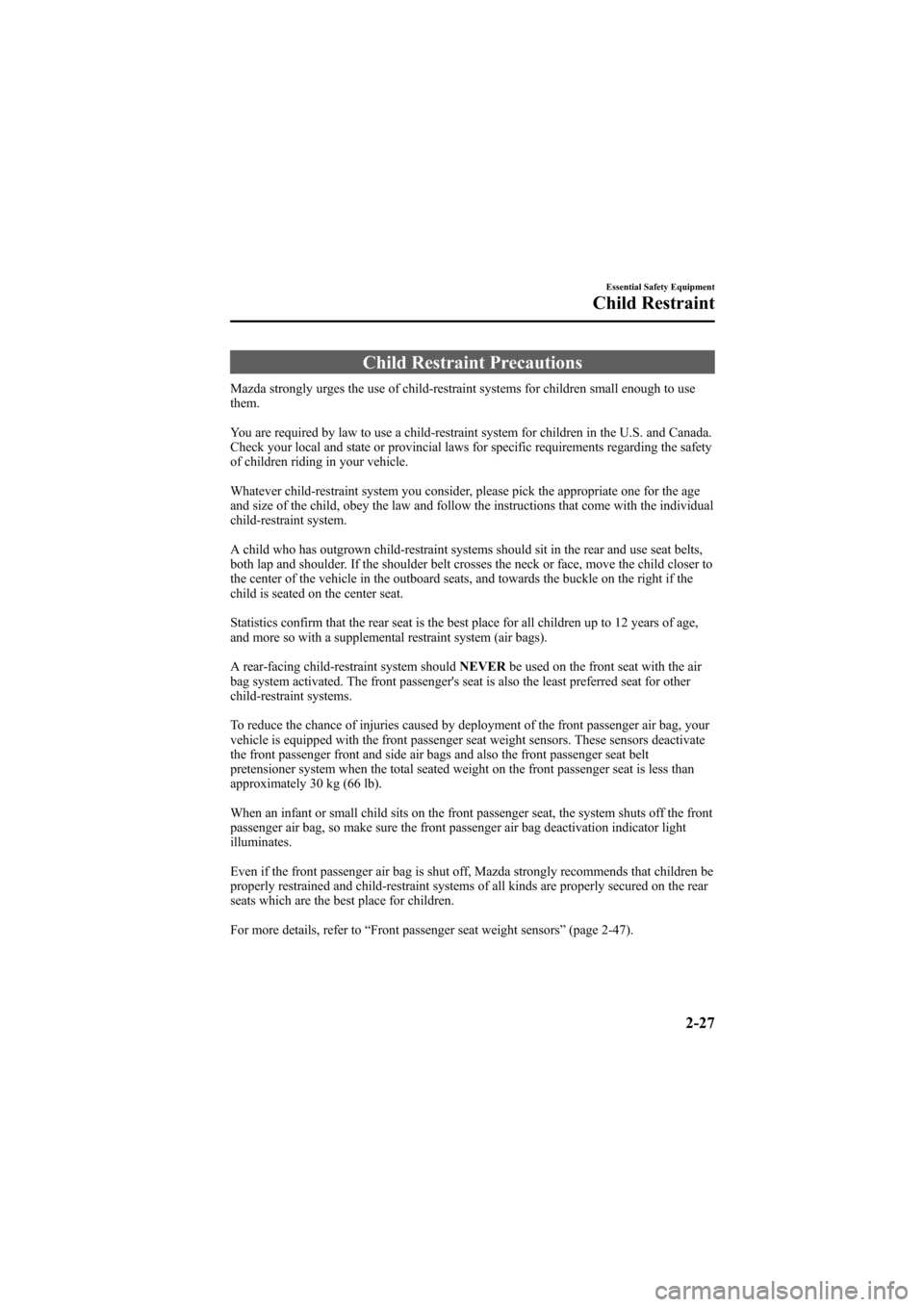
Black plate (39,1)
Child Restraint Precautions
Mazda strongly urges the use of child-restraint systems for children small enough to use
them.
You are required by law to use a child-restraint system for children in the U.S. and Canada.
Check your local and state or provincial laws for specific requirements regarding the safety
of children riding in your vehicle.
Whatever child-restraint system you consider, please pick the appropriate one for the age
and size of the child, obey the law and follow the instructions that come with the individual
child-restraint system.
A child who has outgrown child-restraint systems should sit in the rear and use seat belts,
both lap and shoulder. If the shoulder belt crosses the neck or face, move the child closer to
the center of the vehicle in the outboard seats, and towards the buckle on the right if the
child is seated on the center seat.
Statistics confirm that the rear seat is the best place for all children up to 12 years of age,
and more so with a supplemental restraint system (air bags).
A rear-facing child-restraint system shouldNEVERbe used on the front seat with the air
bag system activated. The front passenger's seat is also the least preferred seat for other
child-restraint systems.
To reduce the chance of injuries caused by deployment of the front passenger air bag, your
vehicle is equipped with the front passenger seat weight sensors. These sensors deactivate
the front passenger front and side air bags and also the front passenger seat belt
pretensioner system when the total seated weight on the front passenger seat is less than
approximately 30 kg (66 lb).
When an infant or small child sits on the front passenger seat, the system shuts off the front
passenger air bag, so make sure the front passenger air bag deactivation indicator light
illuminates.
Even if the front passenger air bag is shut off, Mazda strongly recommends that children be
properly restrained and child-restraint systems of all kinds are properly secured on the rear
seats which are the best place for children.
For more details, refer to “Front passenger seat weight sensors ”(page 2-47).
Essential Safety Equipment
Child Restraint
2-27
Mazda6_8Z64-EA-08H_Edition1 Page39
Wednesday, June 25 2008 10:3 AM
Form No.8Z64-EA-08H
Page 41 of 464
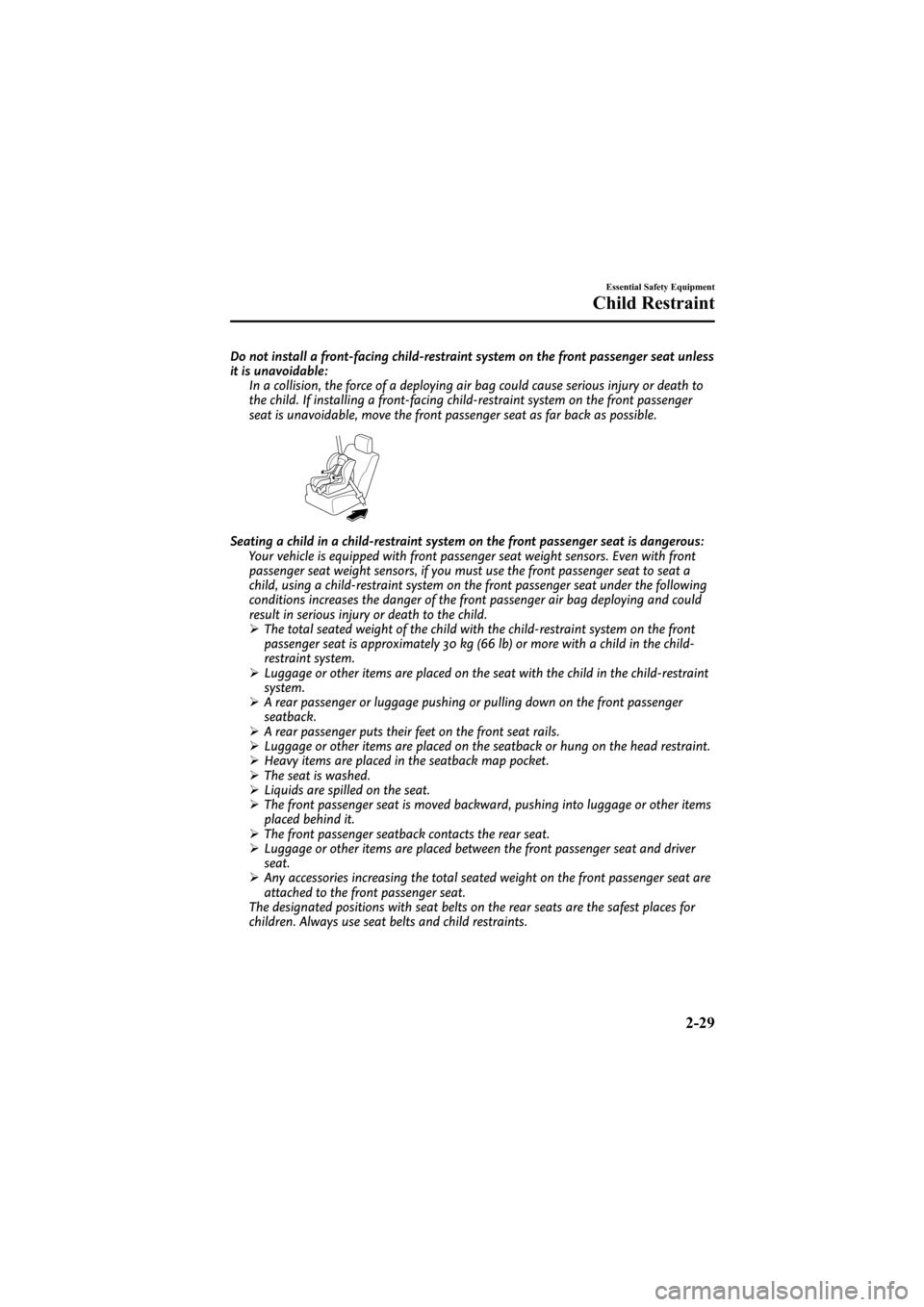
Black plate (41,1)
Do not install a front-facing child-restraint system on the front passenger seat unless
it is unavoidable:In a collision, the force of a deploying air bag could cause serious injury or death to
the child. If installing a front-facing child-restraint system on the front passenger
seat is unavoidable, move the front passenger seat as far back as possible.
Seating a child in a child-restraint system on the front passenger seat is dangerous:Your vehicle is equipped with front passenger seat weight sensors. Even with front
passenger seat weight sensors, if you must use the front passenger seat to seat a
child, using a child-restraint system on the front passenger seat under the following
conditions increases the danger of the front passenger air bag deploying and could
result in serious injury or death to the child.
ØThe total seated weight of the child with the child-restraint system on the front
passenger seat is approximately 30 kg (66 lb) or more with a child in the child-
restraint system.
Ø Luggage or other items are placed on the seat with the child in the child-restraint
system.
Ø A rear passenger or luggage pushing or pulling down on the front passenger
seatback.
Ø A rear passenger puts their feet on the front seat rails.
Ø Luggage or other items are placed on the seatback or hung on the head restraint.
Ø Heavy items are placed in the seatback map pocket.
Ø The seat is washed.
Ø Liquids are spilled on the seat.
Ø The front passenger seat is moved backward, pushing into luggage or other items
placed behind it.
Ø The front passenger seatback contacts the rear seat.
Ø Luggage or other items are placed between the front passenger seat and driver
seat.
Ø Any accessories increasing the total seated weight on the front passenger seat are
attached to the front passenger seat.
The designated positions with seat belts on the rear seats are the safest places for
children. Always use seat belts and child restraints.
Essential Safety Equipment
Child Restraint
2-29
Mazda6_8Z64-EA-08H_Edition1 Page41
Wednesday, June 25 2008 10:3 AM
Form No.8Z64-EA-08H
Page 43 of 464
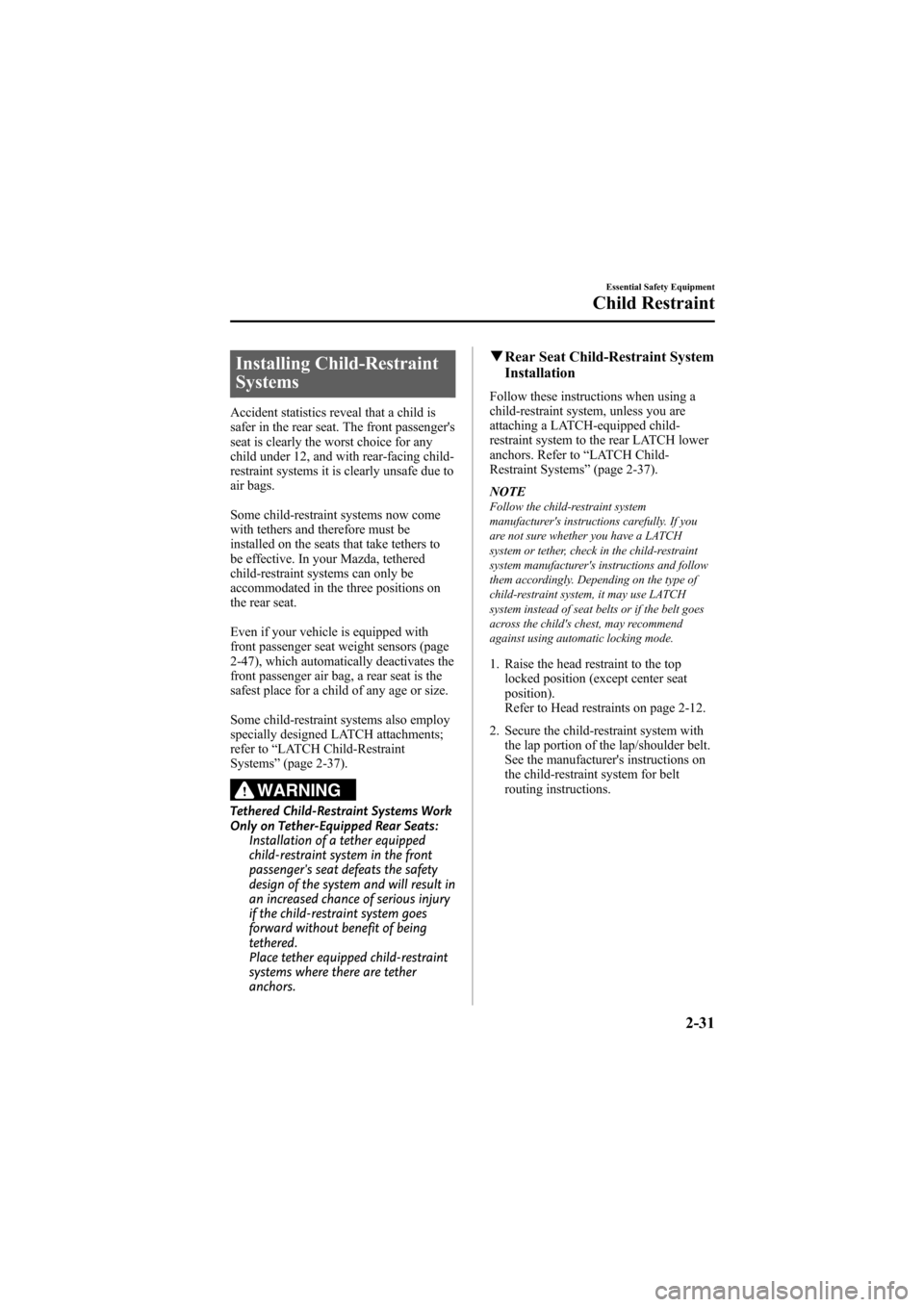
Black plate (43,1)
Installing Child-Restraint
Systems
Accident statistics reveal that a child is
safer in the rear seat. The front passenger's
seat is clearly the worst choice for any
child under 12, and with rear-facing child-
restraint systems it is clearly unsafe due to
air bags.
Some child-restraint systems now come
with tethers and therefore must be
installed on the seats that take tethers to
be effective. In your Mazda, tethered
child-restraint systems can only be
accommodated in the three positions on
the rear seat.
Even if your vehicle is equipped with
front passenger seat weight sensors (page
2-47), which automatically deactivates the
front passenger air bag, a rear seat is the
safest place for a child of any age or size.
Some child-restraint systems also employ
specially designed LATCH attachments;
refer to“LATCH Child-Restraint
Systems ”(page 2-37).
WARNING
Tethered Child-Restraint Systems Work
Only on Tether-Equipped Rear Seats:
Installation of a tether equipped
child-restraint system in the front
passenger's seat defeats the safety
design of the system and will result in
an increased chance of serious injury
if the child-restraint system goes
forward without benefit of being
tethered.
Place tether equipped child-restraint
systems where there are tether
anchors.
qRear Seat Child-Restraint System
Installation
Follow these instructions when using a
child-restraint system, unless you are
attaching a LATCH-equipped child-
restraint system to the rear LATCH lower
anchors. Refer to “LATCH Child-
Restraint Systems ”(page 2-37).
NOTE
Follow the child-restraint system
manufacturer's instructions carefully. If you
are not sure whether you have a LATCH
system or tether, check in the child-restraint
system manufacturer's instructions and follow
them accordingly. Depending on the type of
child-restraint system, it may use LATCH
system instead of seat belts or if the belt goes
across the child's chest, may recommend
against using automatic locking mode.
1. Raise the head restraint to the top locked position (except center seat
position).
Refer to Head restraints on page 2-12.
2. Secure the child-restraint system with the lap portion of the lap/shoulder belt.
See the manufacturer's instructions on
the child-restraint system for belt
routing instructions.
Essential Safety Equipment
Child Restraint
2-31
Mazda6_8Z64-EA-08H_Edition1 Page43
Wednesday, June 25 2008 10:3 AM
Form No.8Z64-EA-08H
Page 45 of 464
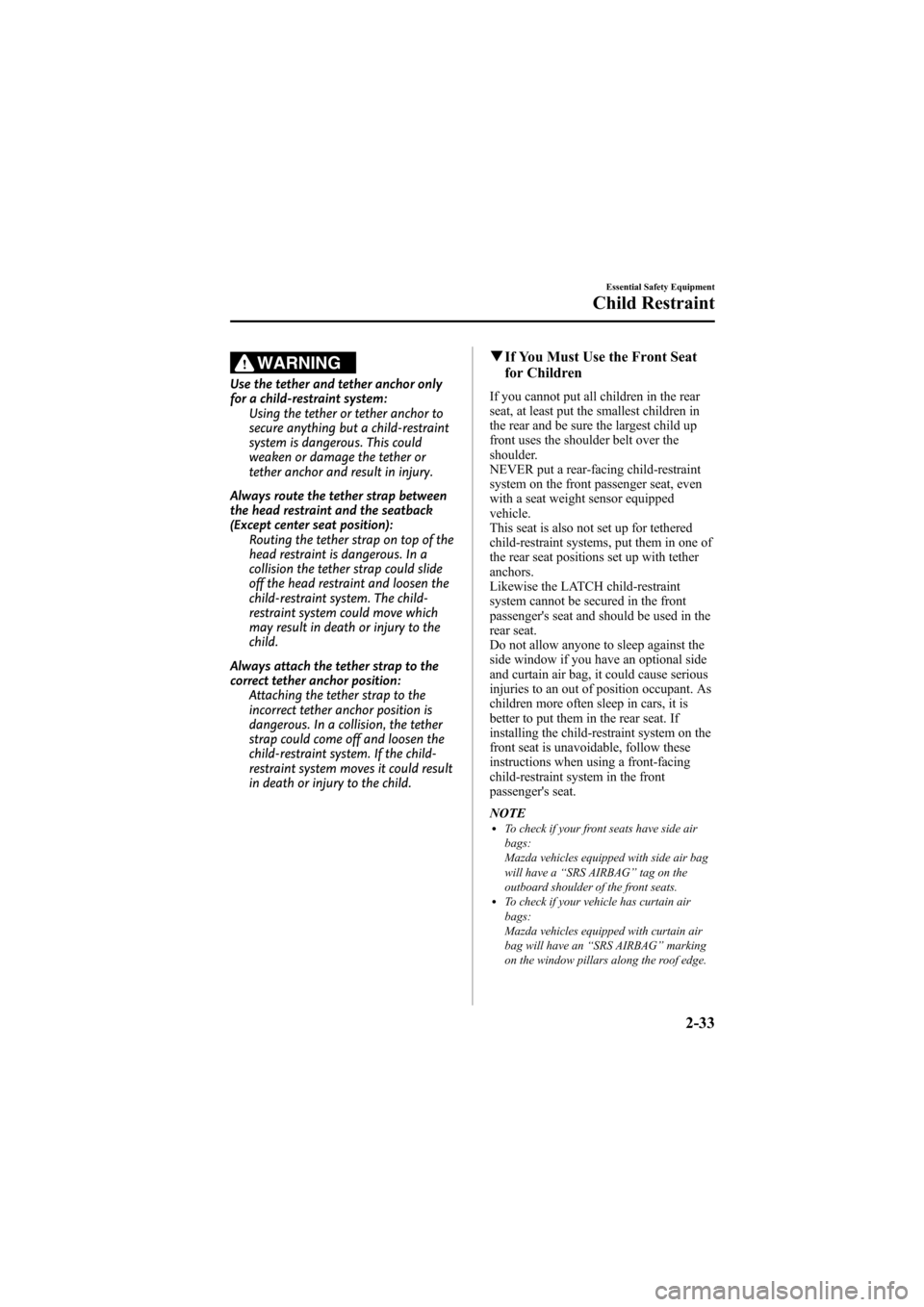
Black plate (45,1)
WARNING
Use the tether and tether anchor only
for a child-restraint system:Using the tether or tether anchor to
secure anything but a child-restraint
system is dangerous. This could
weaken or damage the tether or
tether anchor and result in injury.
Always route the tether strap between
the head restraint and the seatback
(Except center seat position): Routing the tether strap on top of the
head restraint is dangerous. In a
collision the tether strap could slide
off the head restraint and loosen the
child-restraint system. The child-
restraint system could move which
may result in death or injury to the
child.
Always attach the tether strap to the
correct tether anchor position: Attaching the tether strap to the
incorrect tether anchor position is
dangerous. In a collision, the tether
strap could come off and loosen the
child-restraint system. If the child-
restraint system moves it could result
in death or injury to the child.
qIf You Must Use the Front Seat
for Children
If you cannot put all children in the rear
seat, at least put the smallest children in
the rear and be sure the largest child up
front uses the shoulder belt over the
shoulder.
NEVER put a rear-facing child-restraint
system on the front passenger seat, even
with a seat weight sensor equipped
vehicle.
This seat is also not set up for tethered
child-restraint systems, put them in one of
the rear seat positions set up with tether
anchors.
Likewise the LATCH child-restraint
system cannot be secured in the front
passenger's seat and should be used in the
rear seat.
Do not allow anyone to sleep against the
side window if you have an optional side
and curtain air bag, it could cause serious
injuries to an out of position occupant. As
children more often sleep in cars, it is
better to put them in the rear seat. If
installing the child-restraint system on the
front seat is unavoidable, follow these
instructions when using a front-facing
child-restraint system in the front
passenger's seat.
NOTE
lTo check if your front seats have side air
bags:
Mazda vehicles equipped with side air bag
will have a “SRS AIRBAG ”tag on the
outboard shoulder of the front seats.
lTo check if your vehicle has curtain air
bags:
Mazda vehicles equipped with curtain air
bag will have an “SRS AIRBAG ”marking
on the window pillars along the roof edge.
Essential Safety Equipment
Child Restraint
2-33
Mazda6_8Z64-EA-08H_Edition1 Page45
Wednesday, June 25 2008 10:3 AM
Form No.8Z64-EA-08H